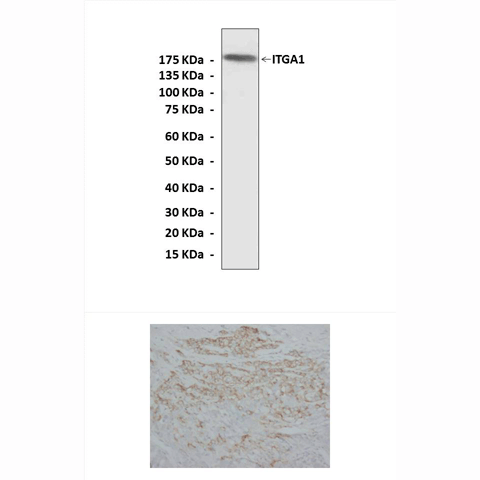Anti-ITGA1: Rabbit Integrin-alpha1 Antibody |
 |
BACKGROUND The Integrins are a family of alpha/betab heterodimeric receptors that mediate dynamic linkages between extracellular adhesion molecules and the intracellular actin cytoskeleton. Integrins are expressed by all multicellular animals, but their diversity varies widely among species; for example, in mammals, 19 alpha and 8 beta subunit genes encode polypeptides that combine to form 25 different receptors. Both Integrin subunits are type I transmembrane proteins with large extracellular and short cytoplasmic domains of 700-1100 and 30-50 residues respectively. Integrins are ubiquitously expressed and at physiological conditions, Integrins are highly glycosylated and contain a Ca2+ or Mg2+ ion, which is essential for ligand binding. Integrin receptors are critical for cell attachment to the extracellular matrix (ECM) and this is mediated through integrin-fibronectin, -vitronectin, -collagen and -laminin interactions. Intracellularly, Integrins form adhesion complexes with proteins including talin, vinculin, paxillin and alpha-actinin. They also regulate kinases, such as focal adhesion kinase and Src family kinases, to mediate attachment to the actin cytoskeleton. Integrins also have a significant role in cell signaling and can activate protein kinases involved in the regulation of cell growth, division, survival, differentiation, migration and apoptosis. The beta 1, beta 3, and beta 5 Integrin intracellular domains are sufficient to initiate signal transduction pathways. Furthermore, alternative splicing can regulate the ability of beta integrin intracellular domains to participate in signal transduction. Glycoprotein II/IIIb (alphaIIb/beta3) is an integrin receptor found on the surface of platelets. It is involved in the cross-linking of platelets with fibrin, and so has a vital role in blood clot formation.1
Integrin-alpha-1 (ITGA1, CD49a) usually occurs in association with integrin-beta-1(ITGB1). The heterodimeric protein is known also as VLA-1 [very late activation antigen 1] and acts as a receptor for laminin and collagen, promoting cell attachment and neurite outgrowth in neural cells and attachment in hematopoietic cells. It was demonstrated that semaphorin 7A stimulates cytokine production in monocytes and macrophages through integrin-alpha-1-beta-1.2 Moreover, it was also shown that expression of integrin-alpha-1 is important for effector memory T-cell functions and plays a role in psoriasis.3 Using knock-out mice lacking expression of integrin-alpha-1, it was shown that Integrin-alpha-1 plays an important role in fracture wound healing, which requires its interactions with collagen. Furthermore, integrin-alpha-1 plays an essential role in the regulation of mesenchymal stem cell proliferation and cartilage production. Integrin-alpha-1 has been shown to be involved in the early remodeling process in osteoarthritic cartilage as knock-out mice also show an accelerated, aging-dependent development of osteoarthritis.4
Additionally, Integrin alpha1beta1, a major collagen binding receptor, is expressed in different cell types. It negatively regulates the generation of profibrotic reactive oxygen species (ROS) by inhibiting epidermal growth factor receptor (EGFR) activation. Caveolin-1 (Cav-1), a scaffolding protein, binds integrins and controls growth factor receptor signaling, participates in integrin alpha1beta1-mediated EGFR activation.5 Finally it was shown that that Integrin-alpha-1 confers invasive behavior of tumor cells by regulating stromelysin-1 expression.6
Integrin-alpha-1 (ITGA1, CD49a) usually occurs in association with integrin-beta-1(ITGB1). The heterodimeric protein is known also as VLA-1 [very late activation antigen 1] and acts as a receptor for laminin and collagen, promoting cell attachment and neurite outgrowth in neural cells and attachment in hematopoietic cells. It was demonstrated that semaphorin 7A stimulates cytokine production in monocytes and macrophages through integrin-alpha-1-beta-1.2 Moreover, it was also shown that expression of integrin-alpha-1 is important for effector memory T-cell functions and plays a role in psoriasis.3 Using knock-out mice lacking expression of integrin-alpha-1, it was shown that Integrin-alpha-1 plays an important role in fracture wound healing, which requires its interactions with collagen. Furthermore, integrin-alpha-1 plays an essential role in the regulation of mesenchymal stem cell proliferation and cartilage production. Integrin-alpha-1 has been shown to be involved in the early remodeling process in osteoarthritic cartilage as knock-out mice also show an accelerated, aging-dependent development of osteoarthritis.4
Additionally, Integrin alpha1beta1, a major collagen binding receptor, is expressed in different cell types. It negatively regulates the generation of profibrotic reactive oxygen species (ROS) by inhibiting epidermal growth factor receptor (EGFR) activation. Caveolin-1 (Cav-1), a scaffolding protein, binds integrins and controls growth factor receptor signaling, participates in integrin alpha1beta1-mediated EGFR activation.5 Finally it was shown that that Integrin-alpha-1 confers invasive behavior of tumor cells by regulating stromelysin-1 expression.6
REFERENCES
1. Schwartz, M.A. & Ginsberg, M.H.: et al: Nature Cell Biol. 4:E65-E68, 2002
2. Suzuki, K. et al: Nature 446:680-4, 2007
3. Conrad, C. et al: Nature Medicine 13:836-41, 2007
4. Zemmyo, M. et al: Arthritis Rheum. 48:2873-80, 2003
5. Chen, X. et al: Mol. Cell. Biol. 30:3048-58, 2010
6. Lochter, A. et al: Mol. Biol. Cell 10:271-82, 1999
2. Suzuki, K. et al: Nature 446:680-4, 2007
3. Conrad, C. et al: Nature Medicine 13:836-41, 2007
4. Zemmyo, M. et al: Arthritis Rheum. 48:2873-80, 2003
5. Chen, X. et al: Mol. Cell. Biol. 30:3048-58, 2010
6. Lochter, A. et al: Mol. Biol. Cell 10:271-82, 1999
Products are for research use only. They are not intended for human, animal, or diagnostic applications.
Параметры
Cat.No.: | CA1045 |
Antigen: | Short peptide from human ITGA1 sequence. |
Isotype: | Rabbit IgG |
Species & predicted species cross- reactivity ( ): | Human |
Applications & Suggested starting dilutions:* | WB 1:1000 IP n/d IHC 1:50 - 1:200 ICC n/d FACS n/d |
Predicted Molecular Weight of protein: | 175 kDa |
Specificity/Sensitivity: | Detects endogenous levels of ITGA1 proteins without cross-reactivity with other related proteins. |
Storage: | Store at -20°C, 4°C for frequent use. Avoid repeated freeze-thaw cycles. |
*Optimal working dilutions must be determined by end user.
Документы
Информация представлена исключительно в ознакомительных целях и ни при каких условиях не является публичной офертой








